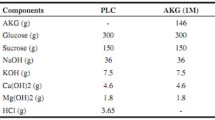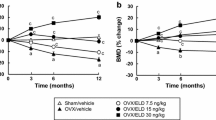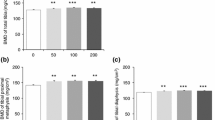Abstract
Background and aims: A positive correlation between intake of antioxidants including vitamins E and C on bone mass has been established by a number of investigators. The present study was conducted to evaluate the extent to which higher doses of vitamin E than normal dose (75 IU per kg diet) can reverse bone loss in aged osteopenic orchidectomizedmale rats. Methods: Forty 12-month old male Sprague-Dawley rats were either sham-operated (Sham) or orchidectomized (Orx), and fed control diet for 120 days to establish bone loss. Thereafter, rats were assigned to their corresponding treatment groups (n= 10 per group): Sham and one Orx groups received 75 IU vitamin E and served as controls, and the other two Orx groups received either 250 or 500 IU vitamin E per kg diet for 90 days. Results: Higher doses of vitamin E did not improve bone mineral density (BMD) or content (BMC) of whole body, femur and lumbar vertebra or alter the orchidectomy-induced deterioration of trabecular microarchitecture of the distal femur metaphysis in comparison with Orx controls that received adequate vitamin E. Biochemical markers of bone formation and bone resorption, i.e. serum osteocalcin and urinary deoxypyridinoline crosslinks, were also unaffected by vitamin E supplementation. Conclusions: Overall, the findings of the present study suggest that supplemental doses of vitamin E do not increase BMD values in male rat model of osteoporosis. However, human studies are needed to confirm the population findings indicating that individuals with higher vitamin E intake have higher bone mass.
Similar content being viewed by others
References
Orwoll ES, Klein RF. Osteoporosis in men. Endocr Rev 1995; 16: 87–116.
Olszynski WP, Shawn DK, Adachi JD et al. Osteoporosis in men: epidemiology, diagnosis, prevention, and treatment. Clin Ther 2004; 26: 15–28.
Kamel HK. Male osteoporosis: new trends in diagnosis and therapy. Drugs Aging 2005; 22: 741–8.
Potts JT. Parathyroid hormone: past and present. J Endocrinol 2005; 187: 311–25.
Slater S, Oliver RT. Testosterone: its role in development of prostate cancer and potential risk from use as hormone replacement therapy. Drugs Aging 2000; 17: 431–9.
Dixon JM. Hormone replacement therapy and the breast. BMJ 2001; 323: 1381–2.
Marcus R. Post-menopausal osteoporosis. Best Pract Res Clin Obstet Gynaecol 2002; 16: 309–27.
Tan RS, Salazar JA. Risks of testosterone replacement therapy in ageing men. Expert Opin Drug Saf 2004; 3: 599–606.
Seeman E. The growth and age-related origins of bone fragility in men. Calcif Tissue Int 2004; 75: 100–9.
Raisz LG. Bone cell biology: new approaches and unanswered questions. J Bone Miner Res 1993; 8: S457–65.
Tarn VK, Schotland S, Green J. Inflammatory cytokines (IL-lalpha, TNF-alpha) and LPS modulate the Ca2+ signaling pathway in osteoblasts. Am J Physiol 1998; 274: C1686–98.
Traianedes K, Dallas MR, Garrett IR, Mundy GR, Bonewald LF. 5-Lipoxygenase metabolites inhibit bone formation in vitro. Endocrinology 1998; 139: 3178–84.
Manolagas SC. Birth and death of bone cells: basic regulatory mechanisms and implications for the pathogenesis and treatment of osteoporosis. Endocr Rev 2000; 21: 115–37.
Cheleuitte D, Mizuno S, Glowacki J. In vitro secretion of cytokines by human bone marrow: effects of age and estrogen status. J Clin Endocrinol Metab 1998; 83: 2043–51.
Harman SM, Metter EJ, Tobin JD, Pearson J, Blackman MR. Longitudinal effects of aging on serum total and free testosterone levels in healthy men. Baltimore Longitudinal Study of Aging. J Clin Endocrinol Metab 2001; 86: 724–31.
Walston J, Arking DE, Fallin D et al. IL-6 gene variation is not associated with increased serum levels of IL-6, muscle, weakness, or frailty in older women. Exp Gerontol 2005; 40: 344–52.
Dinarello CA. Interleukin 1 and interleukin 18 as mediators of inflammation and the aging process. Am J Clin Nutr 2006; 83: 447S–55S.
Bartocci A, Papademetriou V, Schlick E, Nisula BC, Chirigos MA. Effect of crude and purified human chorionic gonadotropin on murine delayed-type hypersensitivity: a role for prostaglandins. Cell Immunol 1982; 71: 326–33.
Meydani SN, Meydani M, Verdon CP, Shapiro AA, Blumberg JB, Hayes KC. Vitamin E supplementation suppresses prostaglandin El(2) synthesis and enhances the immune response of aged mice. Mech Ageing Dev 1986; 34: 191–201.
Meydani SN, Barklund MP, Liu S et al. Vitamin E supplementation enhances cell-mediated immunity in healthy elderly subjects. Am J Clin Nutr 1990; 52: 557–63.
Hayek MG, Meydani SN, Meydani M, Blumberg JB. Age differences in eicosanoid production of mouse splenocytes: effects on mitogen-induced T-cell proliferation. J Gerontol 1994; 49: B197–207.
Hayek MG, Mura C, Wu D et al. Enhanced expression of inducible cyclooxygenase with age in murine macrophages. J Immunol 1997; 159: 2445–51.
Wu D, Mura C, Beharka AA et al. Age-associated increase in PGE2 synthesis and COX activity in murine macrophages is reversed by vitamin E. Am J Physiol 1998; 275: C661–8.
Nathan CF. Secretory products of macrophages. J Clin Invest 1987; 79: 319–26.
Mundy GR. Cytokines and growth factors in the regulation of bone remodeling. J Bone Miner Res 1993; 8: S505–10.
Garrett IR, Boyce BF, Oreffo RO, Bonewald L, Poser J, Mundy GR. Oxygen-derived free radicals stimulate osteoclastic bone resorption in rodent bone in vitro and in vivo. J Clin Invest 1990; 85: 632–9.
van’t Hof RJ, Ralston SH. Nitric oxide and bone. Immunology 2001; 103: 255–61.
Gokturk E, Turgut A, Baycu C, Gunal I, Seber S, Gulbas Z. Oxygen-free radicals impair fracture healing in rats. Acta Orthop Scand 1995; 66: 473–5.
Lean JM, Davies JT, Fuller K et al. A crucial role for thiol antioxidants in estrogen-deficiency bone loss. J Clin Invest 2003; 112: 915–23.
Jagger CJ, Lean JM, Davies JT, Chambers TJ. Tumor necrosis factor-alpha mediates osteopenia caused by depletion of antioxidants. Endocrinology 2005; 146: 113–8.
Crary EJ, McCarty MF. Potential clinical applications for high-dose nutritional antioxidants. Med Hypotheses 1984; 13: 77–98.
Azzi A, Breyer I, Feher M et al. Specific cellular responses to alpha-tocopherol. J Nutr 2000; 130: 1649–52.
Ricciarelli R, Zingg JM, Azzi A. Vitamin E: protective role of a Janus molecule. FASEB J 2001; 15: 2314–25.
Wang Y, Huang DS, Liang B, Watson RR. Nutritional status and immune responses in mice with murine AIDS are normalized by vitamin E supplementation. J Nutr 1994; 124: 2024–32.
van Tits LJ, Demacker PN, de GJ, Hak-Lemmers HL, Stalenhoef AF. alpha-tocopherol supplementation decreases production of superoxide and cytokines by leukocytes ex vivo in both normolipidemic and hypertriglyceridemic individuals. Am J Clin Nutr 2000; 71: 458–64.
Jialal I, Devara] S, Kaul N. The effect of alpha-tocopherol on monocyte proatherogenic activity. J Nutr 2001; 131: 389S–94S.
Wu D, Hayek MG, Meydani S. Vitamin E and macrophage cyclooxygenase regulation in the aged. J Nutr 2001; 131: 382S–8S.
Asehnoune K, Strassheim D, Mitra S, Kim JY, Abraham E. Involvement of reactive oxygen species in Toll-like receptor 4-dependent activation of NF-kappa B. J Immunol 2004; 172:2522–9.
Manolagas SC, Jilka RL. Bone marrow, cytokines, and bone remodeling. Emerging insights into the pathophysiology of osteoporosis. N Engl J Med 1995; 332: 305–11.
Jilka RL, Weinstein RS, Takahashi K, Parfitt AM, Manolagas SC. Linkage of decreased bone mass with impaired osteoblastogenesis in a murine model of accelerated senescence. J Clin Invest 1996; 97: 1732–40.
Xu H, Watkins BA, Seifert MF. Vitamin E stimulates trabecular bone formation and alters epiphyseal cartilage morphometry. Calcif Tissue Int 1995; 57: 293–300.
Melhus H, Michaelsson K, Holmberg L, Wolk A, Ljunghall S. Smoking, antioxidant vitamins, and the risk of hip fracture. J Bone Miner Res 1999; 14: 129–35.
Smith BJ, Lucas EA, Turner RT et al. Vitamin E provides protection for bone in mature hindlimb unloaded male rats. Calcif Tissue Int 2005; 76: 272–9.
Arjmandi B, Juma S, Beharka A, Bapna M, Akhter M, Meydani S. Vitamin E improves bone quality in the aged but not in young adult male mice. J Nutr Biochem 2002; 13: 543–9.
Lane NE, Haupt D, Kimmel DB, Modin G, Kinney JH. Early estrogen replacement therapy reverses the rapid loss of trabecular bone volume and prevents further deterioration of connectivity in the rat. J Bone Miner Res 1999; 14: 206–14.
Deyhim F, Stoecker BJ, Brusewitz GH, Devareddy L, Arjmandi BH. Dried plum reverses bone loss in an osteopenic rat model of osteoporosis. Menopause 2005; 12: 755–62.
Muller R, Ruegsegger P. Three-dimensional finite element modelling of non-invasively assessed trabecular bone structures. Med Eng Phys 1995; 17: 126–33.
Cattaneo PM, Dalstra M, Frich LH. A three-dimensional finite element model from computed tomography data: a semi-automated method. Proc Inst Mech Eng [H] 2001; 215: 203–13.
Keyak JH, Meagher JM, Skinner HB, Mote CD Jr. Automated three-dimensional finite element modelling of bone: a new method. J Biomed Eng 1990; 12: 389–97.
Newitt DC, Majumdar S, Van RB et al. In vivo assessment of architecture and micro-finite element analysis derived indices of mechanical properties of trabecular bone in the radius. Osteoporos Int 2002; 13: 6–17.
van Rietbergen B, Odgaard A, Kabel J, Huiskes R. Direct mechanics assessment of elastic symmetries and properties of trabecular bone architecture. J Biomech 1996; 29: 1653–7.
Meydani M. Vitamin E and atherosclerosis: beyond prevention of LDL oxidation. J Nutr 2001; 131: 366S–8S.
Dutta A, Dutta SK. Vitamin E and its role in the prevention of atherosclerosis and carcinogenesis: a review. J Am Coll Nutr 2003; 22: 258–68.
Beharka AA, Wu D, Han SN, Meydani SN. Macrophage prostaglandin production contributes to the age-associated decrease in T cell function which is reversed by the dietary antioxidant vitamin E. Mech Ageing Dev 1997; 93: 59–77.
Wu D, Meydani M, Beharka AA, Serafini M, Martin KR, Meydani SN. In vitro supplementation with different tocopherol homologues can affect the function of immune cells in old mice. Free Radic Biol Med 2000; 28: 643–51.
Pfeilschifter J, Koditz R, Pfohl M, Schatz H. Changes in proinflammatory cytokine activity after menopause. Endocr Rev 2002; 23: 90–119.
Cheleuitte D, Mizuno S, Glowacki J. In vitro secretion of cytokines by human bone marrow: effects of age and estrogen status. J Clin Endocrinol Metab 1998; 83: 2043–51.
Beharka AA, Han SN, Adolfsson O et al. Long-term dietary antioxidant supplementation reduces production of selected inflammatory mediators by murine macrophages. Nutr Res 2000; 20: 281–96.
Yee JK, Ima-Nirwana S. Palm vitamin E protects against ferric nitrilotriacetate-induced impairment of bone calcification. Asia Pacific J Pharmacol 1998; 13: 1–7.
Norazlina M, Ima-Nirwana S, Gapor MT, Khalid BAK. Palm vitamin E is comparable to α-tocopherol in maintaining bone mineral density in ovariectomised female rats. Exp Clin Endocrinol Diabetes 2000; 108: 305–10.
Norazlina M, Lee PL, Lukman HI, Nazrun AS, Ima-Nirwana S. Effects of vitamin E supplementation on bone metabolism in nicotine-treated rats. Singapore Med J 2007; 48: 195–99.
Author information
Authors and Affiliations
Corresponding author
Rights and permissions
About this article
Cite this article
Chai, S.C., Wei, CI., Brummel-Smith, K. et al. The role of vitamin E in reversing bone loss. Aging Clin Exp Res 20, 521–527 (2008). https://doi.org/10.1007/BF03324879
Received:
Accepted:
Published:
Issue Date:
DOI: https://doi.org/10.1007/BF03324879




